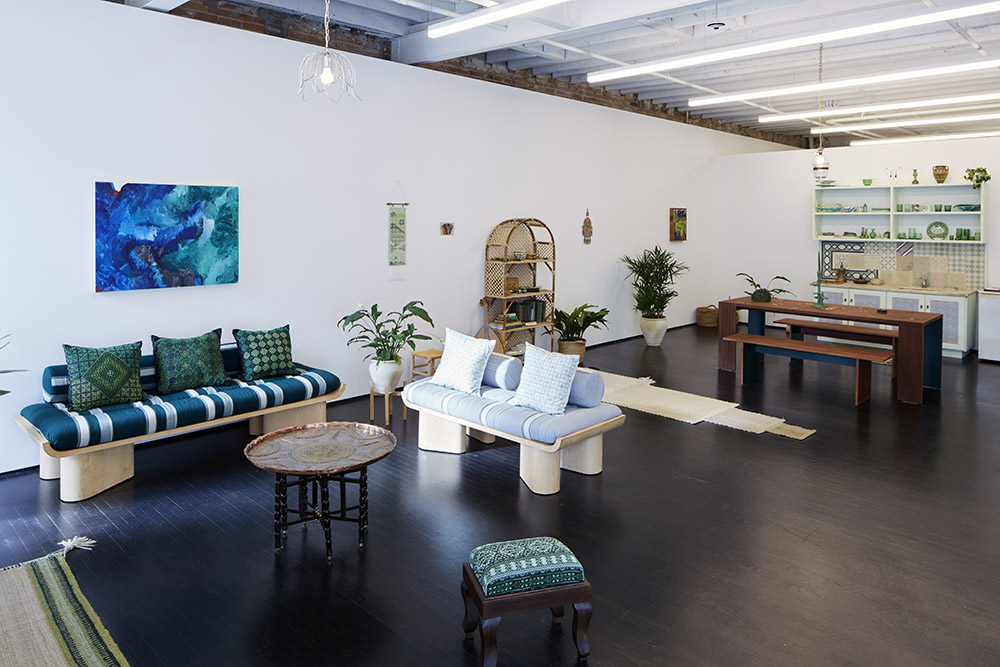
Opening at the end of a very long year that many people spent in varying degrees of lockdown, Jordan Nassar’s current exhibition at Louisville’s KMAC Museum achieves what I would have thought impossible: it evokes a longing for home.
The Field is Infinite greets the viewer with the Palestinian-American artist’s 2019 work The Sea Beneath Our Eyes, a recreation, born out of nostalgia, of a small Middle Eastern apartment within the gallery walls. A kitchen area, living room, and bedroom are furnished with handcrafted works that reflect the traditions of the region—pillows embroidered with Palestinian tatreez, ceramics painted with Persian motifs, delicate hamsas hammered out of copper and metal. Nassar commissioned these “housewarming gifts,” as the wall text describes them, from craftspeople in Israel and Palestine, as well as diaspora artists living in and around New York City, where he is based.
Although Nassar conceived of the installation long before the pandemic began, the ongoing travel restrictions only serve to make the emigrant’s yearning for the homeland ever more resonant. We have all developed a collective nostalgia for The Before Times, that golden age in which we could travel freely, be welcomed into the homes of friends and strangers, sit shoulder-to-shoulder at a kitchen table and share wine and stories and music well into the night. Homes are not just residences but places of hospitality, spaces we open to others in affirmation of our enduring need for kinship and connection.

They are also (or once were) intended to provide rest and renewal, a refuge from the chaotic world outside. Soothing shades of azure, teal, olive and mint imbue The Sea Beneath Our Eyes with a presence of calm, no doubt augmented by the absence of televisions and computers. In this dwelling, hypothetically situated in that contentious area between the Mediterranean Sea and the Jordan River, not even a newspaper is permitted to disturb this domestic tranquility, this haven from geopolitical conflict and religious violence. By channeling his own specific notions of home, Nassar connects with the universal desire for protection and belonging.
Beyond the beautifully handcrafted gates of the installation, the exhibition opens out into a colorful, dreamlike expanse—a dazzling array of more than two dozen of Nassar’s embroidered works that would feel overwhelming if not for their keen installation. Rendered in vibrant hues and intricate geometries, the embroideries invigorate an ancient tradition with modern energy and optimism, re-envisioning the war-weary terrain as a rich and fertile expanse, abundant in clear blue waters and lush vegetation.

Nassar brings a painterly sensibility to these abstract landscapes, breaking the formality of both the cross-stitch grid and the geometric patterns of the needlework with broad, irregular swathes of color whose textures induce a sort of haptic rapture. This exuberant exploration of the craft is perhaps most joyfully expressed in a trio of vertical mountainous vistas created in homage to the Lebanese-American poet and artist Etel Adnan; the titles—To Be The Home, To Carry The Moon, To Melt In Mist—are borrowed lines of her poetry.
In an extension of the show’s spirit of collaboration, Nassar created many of the other works with the help of craftswomen living in the West Bank. Rather than dictate their designs, Nassar invited the artisans to embroider pieces of cotton in patterns and colors of their choosing, asking them only to leave a square or rectangle in each interior empty. Here, he made his own contributions, responding to their work with pictorial stitching, almost as if embedding a postcard from some distant shore. How fitting, then, that Nassar uses a canvas (cotton cloth) whose ease of portability allows him to take his ancestral land with him wherever he goes.
While my first instinct in our current call-out, cancel-culture environment was to question Nassar’s choice not to individually credit his collaborators, I just as quickly realized that this would have been an inappropriate gesture, at odds with the intent behind the work. For if there is one idea that permeates The Field is Infinite, it is the belief in community—in the traditions that tie us to the generations that came before us, in the practices that connect us with the friends and family who surround us. It is a bond stronger than borders, an essence that infuses every familiar and treasured object that adorns our private sanctuaries: the very things that tell us we are home.
Jordan Nassar’s solo exhibition The Field is Infinite is on view at the KMAC Museum in Louisville, Kentucky, through April 4, 2021.




